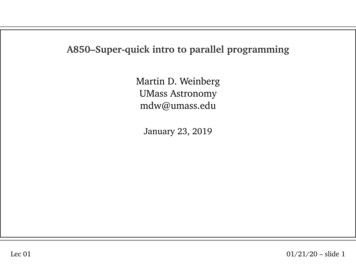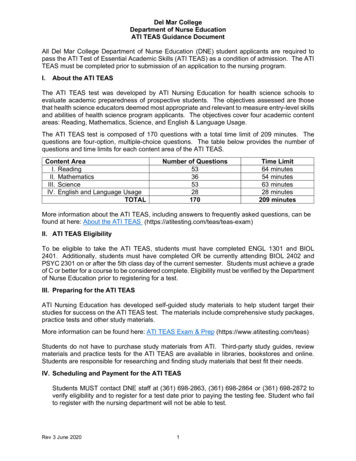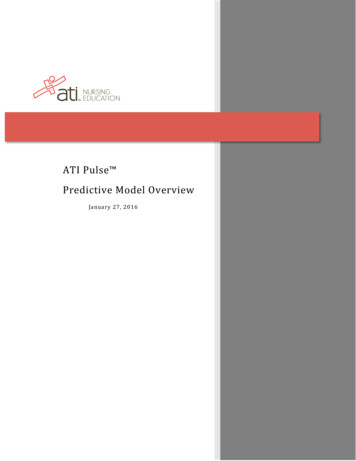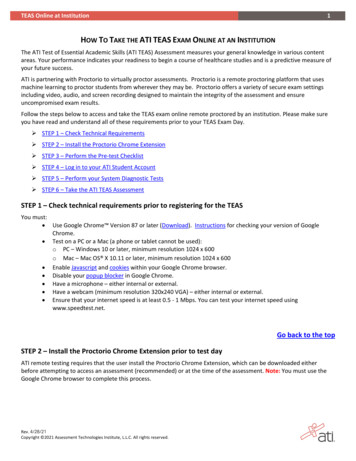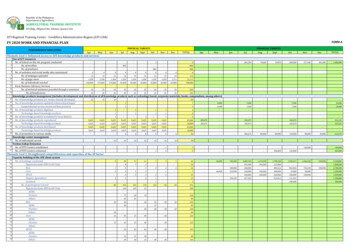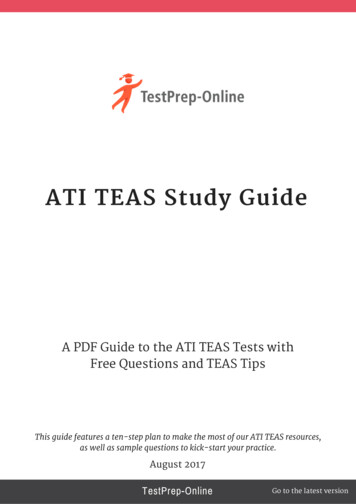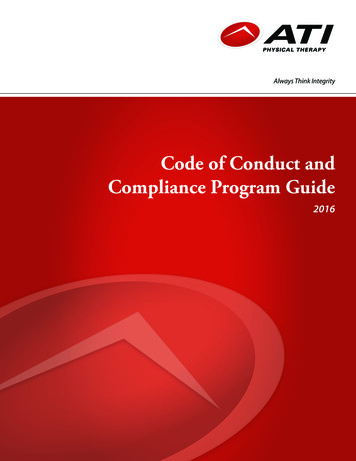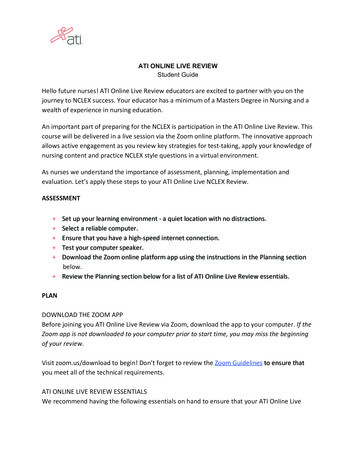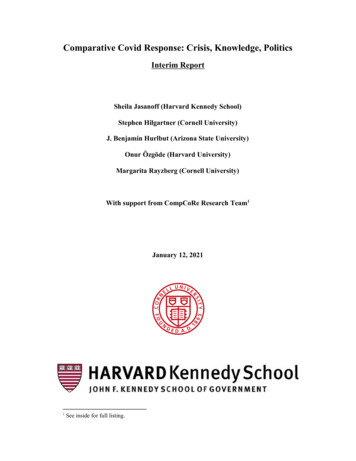
Transcription
Comparative Covid Response: Crisis, Knowledge, PoliticsInterim ReportSheila Jasanoff (Harvard Kennedy School)Stephen Hilgartner (Cornell University)J. Benjamin Hurlbut (Arizona State University)Onur Özgöde (Harvard University)Margarita Rayzberg (Cornell University)With support from CompCoRe Research Team 1January 12, 20211See inside for full listing.
AcknowledgementsThe authors and supporting authors gratefully acknowledge funding from SchmidtFutures and the National Science Foundation (Award Nos. 2028567 and2028585).Supporting authors from the country teams also acknowledge with thanksadditional funding from: Province of Styria (Austria); Bonn University (China);Agence Nationale de la Recherche (France); Belmont Forum and NORFACEJoint Research Programme on Transformations to Sustainability, co-funded byBMBF (Germany); TU Munich (Germany); JST-RISTEX: ELSI-Program#20343950 (Japan); Amsterdam Institute for Social Science Research of theUniversity of Amsterdam (Netherlands); Nanyang Institute of Science andTechnology for Humanity (Singapore); Faculty of Social Sciences at LundUniversity (Sweden); International Network for Government Science Advice(UK); John Fell Fund at Oxford University (UK); Cornell Center for SocialSciences (US); Initiative on Science, Technology and Human Identity at ArizonaState University (US).We also especially thank: Christopher Kirchhoff and Barbara Bush for their tireless support, friendlyprodding, and total intellectual engagement throughout the project Wilmot James and Lyal White for illuminating insights from thecomparative Africa project Distinguished reviewers convened by Schmidt Futures for probing andhelpful comments on earlier drafts Jason Ludwig, Carson Crane, and Louise Xie at Cornell for researchassistance
ParticipantsCompCoRe Leadership TeamSheila Jasanoff (Harvard), Principal InvestigatorStephen Hilgartner (Cornell), Principal InvestigatorJ. Benjamin Hurlbut (Arizona State University)Onur Özgöde (Harvard University)Margarita Rayzberg (Cornell University)CompCoRe Country TeamsAustraliaJeremy Baskin, University of MelbourneSujatha Raman, Australian National UniversityAustriaThomas Buocz, University of GrazIris Eisenberger, University of GrazUlrike Felt, University of ViennaLuca Lindner, University of ViennaNikolaus Pöchhacker, University of GrazBrazilPhilip MacNaghten, Wageningen UniversityGabriela Marques di Giulio, University of São PauloMarko Monteiro, State University of CampinasAlberto Matenhauer Urbinatti, University of CampinoChinaKunhan Li, University of Nottingham Ningbo ChinaMaximilian Mayer, University of BonnNingjie Zhu, University of Nottingham Ningbo ChinaFranceBastien Lafon, Mines ParisTechBrice Laurent, Mines ParisTechGermanySilke Beck, Helmholtz Centre for Environmental Research – UFZJulian Nardmann, Helmholtz Centre for Environmental Research – UFZSebastian Pfotenhauer, Technical University of MunichTimothy van Galen, Technical University of Munich
IndiaBhargavi Rao, Environment Support GroupLeo Saldanha, Environment Support GroupItalyAlessandro Allegra, University College LondonFederico Brandmayr, University of CambridgeEmanuela Gambini, Queens Mary University of LondonLuca Marelli, Katholieke Universiteit LeuvenMariachiara Tallacchini, Catholic University of PiacenzaJapanKohta Juraku, Tokyo Denki UniversityKyoko Sato, Stanford UniversityMikihito Tanaka, Waseda UniversityNetherlandsRob Hagendijk, University of AmsterdamSingaporeShreshtha Jolly, Nanyang Technological UniversityIan McGonigle, Nanyang Technological UniversitySharad Pandian, Nanyang Technological UniversitySouth KoreaSang-Hyun Kim, Hanyang UniversityBuhm Soon Park, Korea Advanced Institute of Science and TechnologySwedenMaria Hedlund, Lund UniversityÅsa Knaggård, Lund UniversityShai Mulinari, Lund UniversityTobias Olofsson, Lund UniversityAndreas Vilhelmsson, Lund UniversityTaiwanShun-Ling Chen, Academia SinicaYu-Ling Huang, National Cheng-Kung UniversityUnited KingdomWarren Pearce, University of SheffieldSolange Rokia, University College LondonJack Stilgoe, University College LondonJames Wilsdon, University of Sheffield
United StatesStephen Hilgartner, Cornell UniversityJ. Benjamin Hurlbut, Arizona State UniversitySheila Jasanoff, Harvard Kennedy SchoolOnur Özgöde, Harvard Kennedy SchoolMargarita Rayzberg, Cornell UniversityAffiliate CountriesIndonesiaSidrotun Naim, IPMI International Business SchoolFebby R. Widjayanto, Airlangga UniversityPeruMelina Galdos Frisancho, University of SussexElvis Mori Macedo, Universidad Antonio Ruiz de MontoyaEnrique Rojas Villalba, Cornell UniversityRogelio Scott Insúa, Cornell UniversitySebastián Zarate Vásquez, North Carolina State University–Raleigh
Table of ContentsPrologueI. IntroductionII. Five FallaciesIII. Puzzles, Paradoxes, and DivergencesIV. Comparative Method: Three Coupled SystemsA. Public HealthB. The EconomyC. PoliticsV. Measures for Managing Public HealthVI. Classifying Countries: Control, Consensus, or ChaosA. Control CountriesB. Consensus CountriesC. Chaos CountriesVII. The 21st Century Social CompactA. The State and The CitizenB. Mobilizing ExpertiseVIII. Key Findings1. Success and failure are contested (and moving) targets2. Politics makes policy, not policy politics3. The social compact matters4. Public health interventions should not be “either-or”5. Protect jobs, not the pocketbooks of the unemployed6. A new globalism – renewing the social compactIX. Hard Truths1. Misreading the world2. Trust in science3. Distrust of public health expertise4. A universal “Playbook” is not the answer5. ResilienceX. Endnotes
XI. ReferencesAppendix A: Country Case iaItalyJapanNetherlandsSingaporeSouth KoreaSwedenTaiwanUnited KingdomUnited States Appendix B: Statistical OverviewPublic health impactsEconomic impacts
PrologueOnce upon a time, three countries faced a terrible plague. The disease slowlysuffocated some while leaving others infected but unharmed. Symptom free, thecarriers unwittingly spread the virus as they went about their normal lives.Thousands sickened, then hundreds of thousands. To respond to this dire threat,each country’s leaders declared war on the disease. Yet each battled it in its ownway, drawing on memories and imaginations of earlier heroic deeds. After a year,the Planetary Council convened to definitively determine which country had donethe best job to fight the plague, and it summoned a citizen from each land to bearwitness.“In my country,” the first citizen began, “the ruling party was initially reluctant toact, and its public health authorities questioned the evidence that the threat wasserious. But once they decided the danger was real, they attacked the disease withmilitary precision. They mobilized the full force of the state—soldiers, doctors,neighbors, drones and smart phones—to find and isolate every carrier of thedisease. The army enforced a nationwide lockdown until infections stopped rising.Once the plague had been contained, ongoing testing suppressed small, localoutbreaks. Soon the disease was completely eradicated. Citizens once again couldgo about their business, and prosperity reigned throughout the land. Looking tothe future, the ruling party decreed that all citizens should henceforth wear aHealth Security Bracelet to monitor their interpersonal contacts andenvironmental exposures to any threat. Party authorities remarked that the HealthSecurity Bracelet may help manage future security threats of other kinds.”“In my land,” sighed the citizen of the second country, “we remember war,poverty, and the prying eyes of the secret police. We know well the dangers ofdisunity and the horrors of unchecked power. We came together to fight the virus,seeking to protect everyone, preserve stability, and negotiate our differences. Ourleaders and scientists talked often. As the severity of the threat grew clear, weclosed our borders, but too late to keep the virus out. Seeking a measuredresponse, we took progressively stronger actions as the disease spread, ultimatelylocking down the country. Alas, many citizens died before we brought the diseaseunder control, and we mourn them all. The state spent vast sums to keep people intheir jobs, and slowly we reopened our economy, and people began to return tonormal life. Soon, however, a second wave hit, bringing new challenges. Asdeaths rose, a new lockdown began, which some resisted. New negotiations areunderway, and we are hopeful that pandemic fatigue will not break ourcommitment to solidarity. Whatever griefs are in store, we know we’ll emergestronger because we faced them together.”The third country could not agree on a spokesperson, so the Council picked anobserver from a neighboring land to provide a neutral report. “Even before theplague struck,” the reporter began, “the citizens were divided into two warringcamps, the Reds and the Blues. Each side distrusted the other’s claims about the
disease, and each believed its view of the plague was based on irrefutable truth.The Reds denied the threat was serious, or even real: a common cold, theyscoffed, or just a hoax to scare us. Based on authoritative science from the bestuniversities, the Blues predicted millions of deaths and sought to lock the countrydown for the collective good. The Reds opposed the lockdown, arguing thatpeople should decide for themselves what risks to accept. The country’s economyfaltered and unemployment skyrocketed. Since the Reds and the Blues couldagree on nothing, they did nothing. The plague spread. Lives and jobs were lost.Political hatred grew. Protesters marched on the capitol, brandishing guns.”After each country had spoken, the Council prepared to deliberate.“Our task,” the Chair began, “is to determine which country had the bestoutcome.”“Obviously,” proclaimed a confident voice, “the country with the lowestnumber of deaths was the most fortunate.”“But age-adjusted!” interjected another. “The deaths of the young surelycount more than the deaths of the old.”“Not so! A human life is a human life,” cried a third.Over the growing din, a fourth voice broke through. “Come to yoursenses! Immediate deaths are just the surface effect of this plague. Economicdisruption destroys lives too, and its effects will last.”“What about the children?” said a fifth. “Their isolation? Their interruptedschooling? Their trauma? What will this do to their mental health, their futureearnings, their ability to form relationships?”“But those effects won’t be known for years,” replied a sixth. “We mustonly consider what we can convincingly count now.”“No! We are morally obliged to make best guesses!” the Chair urged.“On what basis? This catastrophe is without precedent!”“I cannot believe that no person here has raised the matter of liberty!”“Or domestic peace. Do none of you think that that matters?”“It does matter,” the Council Chair conceded. “But what matters most?Health? Prosperity? Liberty? Peace? That is what we are here to determine.”“Is there an objective answer?” said another voice. A long pause followed.“In which country would you choose to live?” a quiet voice asked.At a loss how to address these questions, and frustrated by its failure to identify awinner, the Council adjourned, with no plans to reconvene.
Comparative Covid Response: Crisis, Knowledge, PoliticsFinal ReportI. IntroductionThis report provides a preliminary distillation of Comparative Covid Response:Crisis, Knowledge, Politics (CompCoRe) – a cross-national study of the policyresponses of 16 countries across five continents. Led by a team based at Harvard,Cornell and Arizona State Universities, CompCoRe is a collaborative undertakinginvolving more than 60 researchers from around the world. The participatingcountries are Australia, Austria, Brazil, China, France, Germany, India, Italy,Japan, the Netherlands, Singapore, South Korea, Sweden, Taiwan, the UnitedKingdom, and the United States. Additionally, teams from Indonesia and Peru, aswell as an Africa Group, are included as CompCoRe affiliates. 2The emergence of the novel coronavirus SARS-CoV-2 in 2019 presented theworld with unprecedented challenges. Faced with fast-moving events, scientificand social uncertainty, and tight coupling of public health and economic systems,decision makers struggled to avert catastrophic outcomes. Global institutions suchas the World Health Organization (WHO) provided important, if sometimescontroversial, leadership, but national governments emerged as far and away themost important loci of decision making and policy implementation. As a result,policies were far from uniform, and countries with differing institutions, researchtraditions, cultural commitments, and routinized ways of decision making 3pursued their own directions.Grounded in the field of Science & Technology Studies (STS), 4 but incorporatinginterdisciplinary expertise from law, public policy, and the social sciences,CompCoRe is examining the politics and policies of Covid-19 decision making inthe study countries. We pay special attention to national efforts to identify reliableepidemiological and biomedical knowledge; make difficult public healthdecisions; manage the economic fallout of the pandemic; and build the politicalsupport needed for effective implementation. Cross-national comparison offers apowerful method for identifying and explaining similarities and differencesamong the countries, for promoting societal learning, and for derivingpolicy-relevant insights.A year into the Covid-19 pandemic, many are asking which country did best atmanaging the crisis and produced the best outcomes. This comparative study2CompCoRe is exchanging information and ideas with researchers in the affiliate countries. Thisreport is based on the 16 participating countries.3Sheila Jasanoff, Designs on Nature: Science and Democracy in Europe and the United States(Princeton, NJ: Princeton University Press, 2005).4Ulrike Felt et al., eds., The Handbook of Science and Technology Studies, Fourth (Cambridge,MA: MIT Press, 2017).
shows that these are the wrong questions, and, given the scale of the disruptions,they are being asked prematurely. We identified five common fallacies that ourstudy refutes. To learn from this crisis, future policymakers must abandon thesefallacies and use the findings as a guide to developing more robust and resilientresponses.II. Five FallaciesFallacy 1: A playbook can manage a plague.Our study shows the opposite: Playbooks presume performers will play their prescribed parts. A playbook works only if key actors agree it is the right play. If politics changes, players may throw out the script and play a differentgame. For example: Taiwan successfully played the SARS playbook.Germany played the reunification and 2008 financial crisis scripts tomanage its economy well. The US administration disregarded the Ebolaplaybook and played a different game.Fallacy 2: In an emergency, politics takes a backseat to policy.Our study shows the opposite: Emergencies amplify preexisting conditions in economic and politicalsystems. In polarized societies, crises aggravate divisions such as racial andeconomic disparities, political hyper-partisanship, and distrust ofgoverning elites (e.g., Brazil, India, US). In consensual societies, crises reinforce preexisting solidarity: peopletemporarily set aside differences and support policies for the collectivegood (e.g., France, Japan, Germany, Netherlands, Singapore).Fallacy 3: Indicators of success and failure are clear and outcomes can bewell defined and objectively measured.Our study shows the opposite: Outcome measures are always value-laden, always contested, and alwayserase important features of their context. Performance measures are often contradictory, and experts disagree aboutwhich ones are right or important. Which indicators seem salient changes over the course of a crisis. How outcomes are perceived depends on which indicators are used. Choosing indicators to evaluate policies is therefore a political decision.Fallacy 4: Science advisors enable policymakers to choose the best policies.Our study shows the opposite: In crisis situations, technical knowledge is subject to interpretation andexperts rarely speak with one voice. In many countries, conflicting expert advice is the norm not the exception(e.g., Brazil, Netherlands, UK, US).
Trust in official advice correlates with trust in government (e.g., Germany,Netherlands, Singapore).Fallacy 5: Distrust in public health advice reflects scientific illiteracy.Our study shows the opposite: Vigorous debates about the “facts” occur between experts, and not onlybetween experts and lay people (e.g., Italy, Netherlands, UK, US). Estimates, models, numbers, predictions, and overconfident expertrecommendations based on evolving data can change rapidly during acrisis (e.g., Ferguson on epidemiology [UK], Fauci on masks [US]). Vaccine hesitancy stems in part from cultural experiences with medicine(e.g., exploitation or marginalization).III. Puzzles, Paradoxes, and DivergencesA central puzzle of Covid-19 is why some nations have contained the virus almostcompletely while others have struggled to prevent multiple waves of communitytransmission. Equally puzzling is why nations with evolved resources to combat apandemic have sometimes fared worse than countries with fewer resources. Afurther paradox is why nations with similar systems of government anddemographics have experienced the pandemic with significantly different politicaland economic repercussions. In sum, confronted with the same phenomenon—apandemic caused by a novel virus—countries have diverged in how theyperceived the problem, what resources they mobilized to tackle it, how muchpolitical buy-in they achieved, and to what extent they contained the disease andits economic fallout.The pandemic will continue for some time. Nevertheless, the preliminary findingsoutlined here provide tantalizing insights into why Covid-19 has produceddifferent outcomes in different places, how policymakers can better managenational responses in the months ahead, and what we must do to strengthennational and global systems for future health emergencies. United States: Despite the impressive US achievements in biomedicineand extensive planning for pandemic preparedness, the US record inaddressing the public health crisis of Covid-19 is among the worst in theworld, as evidenced by absolute incidence and fatalities, ongoingeconomic disruption, and extreme political disarray. Germany: Effective response at the national level kept per capitaincidence in Germany lower than in many of its neighbors throughout themultiple waves of transmission that struck Europe. In contrast to the USand Brazil, the German economic response emphasized preserving jobsand economic relationships with the result that stability and social orderwere largely preserved. Emergency measures were broad and inclusive
and did not produce significant controversies around science or policy ofthe sort seen in many other nations. Taiwan: Quick action by a junior health ministry official who heard of theWuhan outbreak on Twitter on December 31, 2019 led health authoritiesto intercept inbound flights that same day and helped stop the spread ofCovid-19 in Taiwan, an island nation, almost immediately. Authoritieshave to date identified 776 cases of Covid-19 and 7 deaths. Expected GDPgrowth for 2020 dropped from 2.5% to 1.1%, but it still left Taiwan in therare position of projecting positive growth for the year. India: With the second highest number of cases and the third highestnumber of deaths in the world, India has been hard hit by Covid-19. Yetthe absolute numbers do not tell the full story, which would have toaccount for large regional differences in reported case-fatality rates. Aunique element of the Indian response was a sudden and drastic lockdownthat drove tens of millions of migrant workers back home to their villages,encountering severe hardships on the road and facing uncertain long-termeconomic prospects. India’s economic recovery may be far moreproblematic than recovery from the disease, where India as a majorvaccine manufacturer enjoys technological advantages. Netherlands: The Dutch Prime Minister announced an “intelligentlockdown” aimed at controlling the virus but not the citizen, who could betrusted to be reasonable and follow expert advice in an appropriatemanner. This response contrasted with the total lockdowns of SouthernEurope and the no-lockdown approach of Sweden. This “intelligentlockdown” worked well initially, but by the second wave of cases in thefall, progress was largely undone, causing the Netherlands to pivot itsresponse sharply, especially with regard to masks. China: After disastrous inaction during the first crucial weeks of theoutbreak when authorities in Wuhan suppressed information andinternational health authorities were not welcomed, the central ChineseCDC implemented a policy of containment with military precision. Theadvanced machinery of digitalized state surveillance was mobilized, andmillions of citizens were tested and checked daily for fever. Treatment indesignated hospitals, combined with partly electronic contact tracing,brought the disease under control, and subsequent small, local outbreakswere successfully suppressed. Brazil: Taking a cue from the public posture of Donald Trump, PresidentJair Bolsonaro scoffed at the virus and pushed for a politically infeasiblepolicy of “vertical isolation,” seeking to target those most at risk whilekeeping the economy open. In the ensuing controversies, a publicly trustedhealth minister was fired for supporting quarantine measures imposed by
governors and mayors, but denounced as economically ruinous byBolsonaro. His successor resigned within weeks. Brazil’s Covid-19 deathtoll rose to be second highest in the world. United Kingdom: Despite having a universal public health systembeloved and trusted by its citizenry, the UK’s per capita case countremains among the highest in the world and its own Prime Minister washospitalized with Covid-19 at a moment of immense debate aboutappropriate containment policies. The government’s official source ofscience advice, the Science Advisory Group for Emergencies (SAGE),was challenged by an unofficial group that dubbed itself IndependentSAGE, or “indieSAGE” for short, 5 which became an oppositional voicecalling for more stringent public health action than the Tory governmentpursued. Australia: In contrast to other federal systems, especially the US, theAustralian government pulled together a unified national response to thepandemic. For the first time, the prime minister established a NationalCabinet 6 that included the heads of all the states and territories, withoutregard to party membership to coordinate a “wartime” response. Strictlockdowns, international and domestic travel restrictions, socialdistancing, and testing, contact tracing, and isolation kept incidence andmortality (908 deaths) to low levels.IV. Comparative Method: Three Coupled SystemsOur study demonstrates that the “war” against the Covid-19 pandemic poseschallenges in three interlinked systems: public health, the economy, and politics.Because public health, economy, and politics are interlinked and “tightly coupled”systems, 7 problems in any of these domains tend to spill over into the others.Policymakers cannot safely intervene in any of these domains in isolation withoutconsideration of the others. Controlling a highly contagious virus spread bypeople who often are asymptomatic poses formidable difficulties. At the sametime, states have faced the problem of managing the worst economic shock sincethe Great Depression, especially at a time when the scars from the 2008 financialcrisis were not yet fully healed. 8 The pandemic also posed serious politicalproblems, including the difficulty of building public support and legitimacy forpolicy decisions that turned normal life on its head. Yet it also offered political“Independent SAGE,” January 6, 2021, https://www.independentsage.org/ .Tom Burton, “National Cabinet Creates a New Federal Model,” March 18, ar .7Charles Perrow, Normal Accidents: Living with High-Risk Technologies (New York, NY: BasicBooks, 1984).8Adam Tooze, Crashed: How a Decade of Financial Crises Changed the World (New York, NY:Viking, 2018).56
opportunities for various actors, affecting election outcomes in countriesincluding France, India, Taiwan, and the US.Just as the virus found and exacerbated preexisting medical conditions inindividual bodies, so the pandemic found and revealed preexisting weaknesses inthe body politic, exploiting and aggravating them. Wherever there were structuralweaknesses in the health, economic, and political systems when the pandemicbegan, the difficulties of coping with the virus significantly worsened them. Bythe same token, countries benefited from structural changes that promotedresilience in response to prior experience. Owing to the importance of the UnitedStates, not to mention its unexpectedly poor results in controlling the epidemic,the US case is especially worth examining in this framework. Below, we comparethe United States with selected countries to illuminate some of the ways in whichthe virus “exploited” preexisting weaknesses in each of the three interlinkedsystems.A. Public HealthThe incidence of and mortality from Covid-19 vary greatly among the 16 studycountries, but in both countries that did well and countries that did poorly bythese metrics, the pandemic disclosed preexisting weaknesses. The United Statesand Singapore illustrate this point. Despite the impressive US achievements inbiomedicine, and despite extensive planning for pandemic preparedness, 9 the USrecord in addressing the public health crisis of Covid-19 is among the worst in theworld. Systemic weaknesses in the US health system are to blame. 10 Theseinclude the lack of a health insurance system that covers all Americans, chronicunderinvestment in elder care, and structural inequalities that produced highvulnerability among essential workers, Black Americans, the poor, andunderserved rural communities. The decentralized structure of the public healthsystem, which devolves public health authority to the 50 states and to subordinateunits such as counties or municipalities, caused delays and gaps in data collection,produced conflict between levels of government, and undermined the authority ofpublic health officials and a deterioration in the felt sovereignty of public health.Singapore’s Covid-19 response, by contrast, is widely seen as a public healthsuccess; yet it also provides an especially clear illustration of the way thepandemic strikes systemic weak spots even in countries with low mortality.Building on recent experience with SARS and H1N1, Singapore established a taskforce in January to “coordinate a whole-of-government, whole-of societyresponse.” Testing and treatment were generally free of charge, contact tracingand extensive disease surveillance were implemented, masks were mandatory,and a “circuit breaker” lockdown was imposed in April. For the first few months,9Andrew Lakoff, Unprepared: Global Health in a Time of Emergency. (Oakland, CA: Universityof California Press, 2017).10Donald A. Barr, Health Disparities in the United States Social Class, Race, Ethnicity, and theSocial Determinants of Health (Baltimore, MD: Johns Hopkins University Press, 2019).
the number of cases in Singapore was low enough that it was touted as a modelresponse which other countries should emulate. However, during the spring andsummer the virus ran rampant in the crowded “dormitories” housing low-wagemigrant workers from India and Bangladesh. As of mid-September, 54,000 of thecountry’s 58,000 cases were among dormitory residents, but mortality remainedlow, with fewer than 30 deaths overall.B. The EconomyThe pandemic hit the United States at a time of exceptional prosperity but itnevertheless produced devastating results. The US was experiencing record lowunemployment and years of growth after recovering from the 2008 financialcrisis. The pandemic precipitated an unprecedented economic shock, withunemployment reaching 14.7 percent in May and the GDP shrinking 9.5 percenton a quarterly basis. Major stock market indexes crashed. Congress and theTrump administration swiftly rolled out a series of stimulus packages, providing atotal of 2 trillion to households and to some companies to retain their workers onpayroll. These actions prevented large-scale corporate defaults, and stock marketsreturned to pre-crisis levels.However, preexisting socioeconomic conditions, notably inequalities in wealth,income, and opportunities, as well as weak protections for labor, soon led tocontroversies. Critics argued that the sum paid to households was too small andthat the federal government was giving too much money to large corporationsrather than smaller, local employers. Payments to companies with connections tothe Trump administration inspired charges of crony capitalism. Debatecrystallized around whether the economic recovery would be V-shaped, with therebound benefiting all, or a bifurcated K-shaped, with the rich doing well whileeconomic conditions for the majority of citizens continued to decline. By latesummer, national debate about economic policy centered on providing a secondround of stimulus, and millions descended into poverty. A compromise agreementwas reached in late December, regarded by many as too little too late.In Brazil, the pandemic began when the country was in the midst of a weakrecovery from its historic 2015-2016 recession, the worst in its history.Unemployment stood at about 12%. These preexisting economic weaknesses wereseverely aggravated by the economic
count more than the deaths of the old." "Not so! A human life is a human life," cried a third. Over the growing din, a fourth voice broke through. "Come to your senses! Immediate deaths are just the surface effect of this plague. Economic disruption destroys lives too, and its effects will last." "What about the children?" said a .
